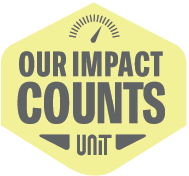Beyond the Triple Bottom Line: The Importance of Measuring Purpose
By Anne Boyle | October 14, 2015
When John Elkington coined the term “triple bottom line” in 1994, he provided a needed framework for businesses wanting to focus on more than profit alone. By measuring the financial, social and environmental performance of a business, triple bottom line accounting not only helps traditional businesses demonstrate their corporate social responsibility, it provides a useful framework for most socially responsible companies. In fact, B Lab, the nonprofit that certifies B Corporations, uses a triple bottom line framework for their B Impact Assessment.
But for B Corps and other for-benefit businesses, measuring what matters is about much more than proving that companies are treating people and the planet well; it’s about proving that business can be a force for positive change in the world. Enter the fourth “P” or the quadruple bottom line.
If you aren’t exactly sure what your Purpose is, check out our resource Purpose First: A Guide to Discovering + Defining Your Company’s Differentiator. It will help you go through the process of defining your Purpose so you can start using it to amplify your positive impact and galvanize your customer community.
What is the Fourth “P”?
Unlike the elements of the triple bottom line, there isn’t clear agreement on what the fourth dimension of the bottom line should be, or whether there should be one at all. Some quadruple bottom line advocates say it should relate to governance, some say morals and ethics, while others argue that it is a spiritual dimension.
I don’t disagree with any of these ideas. One of the reasons the 4th P is tough to define is because it is much more difficult to measure. And that’s a good thing. The quadruple bottom line is rounded out by something less tangible – and perhaps more meaningful – than the measures of the triple bottom line: Purpose.
All businesses have a purpose. For many (though thankfully fewer and fewer), their primary purpose is to make money. Businesses with a social impact Purpose (capital P) seek to make meaningful, significant change in the communities in which they operate – whether local or global.
Purpose as a Promise
For B Corps, Purpose is really a promise. It goes beyond what a company does, and instead focuses on WHY it does it [click to Tweet!]. And the answer to “Why?” isn’t about the CEO or any individual employees. Often it isn’t even about the customers or the company itself. For instance, B Corp d.light aims to “improve the lives of the two billion people in the developing world that live without access to reliable energy.” And B Corp Rubicon Bakery was founded to “help rebuild lives by employing, training, and supporting people [like former prisoners or addicts) who need a second chance.”
Rubicon Bakery gives its employees a second chance at success and gives its customers delicious desserts!
Taking the idea of Purpose as a promise a step further, Steven Kenney offers the notion that the 4th P is actually perspective toward the future rather than just a way of focusing on how to sustain the present. After all, the triple, quadruple and even quintuple (another post entirely) bottom lines are merely frameworks – constructs that help us organize and “make sense of our current realities and work towards a desired future.” In that respect, Purpose as the defining element of the quadruple bottom line hints at the notion that in the future, in order for a business to sustain itself, Purpose won’t be optional.
Whether these frameworks are helpful or limiting remains to be seen. Certainly, as social entrepreneurship and for-benefit companies evolve, so will our frameworks. Perhaps we need to get rid of the frameworks altogether in order to even imagine the ideal future state around which we should build our businesses. But for now, businesses with Purpose are as good a perspective toward the future as any others I’ve seen.
Measuring Purpose
One of the reasons Purpose is so difficult to measure is that it will differ – sometimes wildly – from company to company.
In that case, why should we include it as part of a framework that was originally meant to measure performance in three key areas? Because for a truly for-benefit business, the three other elements of the quadruple bottom line aren’t meaningful without the context of a larger social impact Purpose.
So what do you measure and how do you measure it? The most important measure of Purpose is the answer to variations on one question asked rigorously at decision points across all areas of a business:
How is what we’re doing here contributing to or furthering our Purpose?
This questioning may or may not yield numbers and statistics, but it will help to align your company’s decisions with your Purpose and to gauge how diligently you’re working towards your promised Purpose. Sometimes the telling factor will be what your company DID NOT do because the action didn’t support its Purpose.
The second measure of Purpose is how well your business is articulating and expressing its Purpose and attracting and retaining customers with that Purpose. Purpose is the element that helps a business and its related products / services stand out from the fray in markets where (thankfully) more and more companies are embracing the triple bottom line.
Purpose as a Competitive Edge
Why is it important to articulate and express Purpose to customers? In this Triple Pundit article Zachary Hirschfeld argues that the triple bottom line will die because save for large companies with the bucks to change their operations to be more sustainable, the smaller and mid-sized businesses claiming to be triple bottom line focused are mainly greenwashing. (Hirshfeld comes at the triple bottom line from a purely environmental standpoint, rather than a more holistic sustainability frame).
B Corps and for-benefit companies know this isn’t entirely true, but it is good reason for us to embrace Purpose as the 4th “P” because it offers us a chance to prove this notion wrong. It gives Purpose-driven companies an advantage over non-Purpose-driven companies regardless of size. But it’s only when that Purpose is evident and understood by customers that it can truly be a differentiator.
Of course, the fakers can claim Purpose through PR as well, but B Corps and for-benefit companies can win on brand alignment and focus on customer retention to gain market share. Victory is possible as long as Purpose is infused throughout an organization and then leveraged to connect with customers and other stakeholders. This is where some for-benefit companies are stumbling.
“What?” you may ask: “Shouldn’t for-benefit companies like B Corps have the whole Purpose thing down?” Yes. And most do. Heck, they may have put the quad in quadruple bottom line. But not all of them are expressing their Purpose well and using it as a differentiator.
Here are some companies that are doing – and leveraging – Purpose well:
B Corp Greyston Bakery uses Purpose to drive everything else, including their positioning. Their motto: “We don’t hire people to bake brownies, we bake brownies to hire people.” Their Purpose is their positioning, and it’s infused through everything they do – from supply chain decisions through to marketing. Greyston exemplifies how a strong Purpose can drive the profit, people and planet elements for the bottom line.
B Corp West Paw Design’s Purpose is to conquer the world of pet toys by making environmentally-friendly pet toys and beds. They could just corner the market on organic catnip and pet toys made of eco-fabric and other sustainable materials. Instead they’ve formed the Pet Industry Sustainability Coalition to help everyone in their industry “to work together – not just towards superior products, but towards sustainable, community-minded business solutions.” In this case, West Paw’s Purpose inspired founder Spencer Williams to look beyond his business to his industry as a whole so that even his competitors can pursue West Paw’s Purpose.
Runa, also a B Corp, is another Purpose-first company. When living in Ecuador, founders Tyler Gage and Dan MacCombie saw that the local Kichwa people were drawn to unsustainable activates like logging as a means to support themselves. To provide a sustainable income sources for the Kichwa, they created Runa, an energy drink derived from a naturally caffeinated tree leaf native to the Ecuadorian Amazon called guayusa. The company was born from Purpose: to create a sustainable source of income for the communities that better served them and the planet.

Runa exists to support small farmers in the Amazon while maintaining the integrity of the rainforest.
Share Your Purpose
Don’t let the less tangible measurements of Purpose stop you from sharing your company’s Purpose promise. We can only prove that business can be a force for positive change if we let our Purpose guide everything we do – and share it with the world.
Has your company embraced Purpose as the driver for decisions? How do you measure Purpose? Do you leverage Purpose to further your mission and attract and retain customers? Does it differentiate you from competitors? Tell us about your experience in the comments below.
If you’re struggling with how to define and measure Purpose in your company, or how to infuse Purpose beyond internal discussions, schedule a FREE consultation on activating Purpose.




Great Piece, Anne.. well put..Cliff
Thanks so much, Cliff. I’m glad you enjoyed. And thanks for tweeting it as well!
Best,
Anne